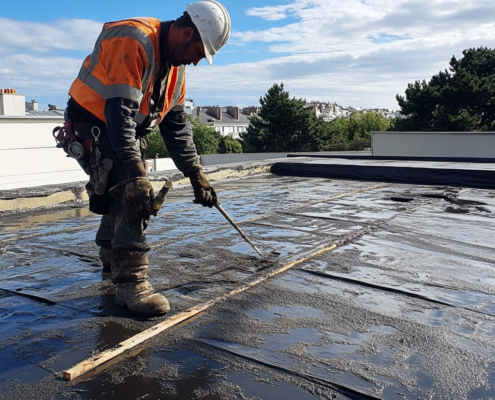The Basics of Flat Roof Repairs: What Every Property Owner Needs to Know
Flat roofs are popular choices for commercial buildings and certain homes due to their minimalistic design and efficient use of space. They come in various materials, including EPDM, PVC, metal, and modified bitumen, each offering unique advantages. However, flat roofs are prone to specific issues, such as water ponding, which can lead to leaks and further damage if not addressed promptly. This comprehensive guide provides step-by-step instructions on identifying and repairing damage on flat roofs, as well as best practices for maintenance to extend your roof’s life.
Flat roof repairs are crucial for maintaining the integrity of your roof and preventing costly damage to your property. Over time, flat roofs can develop leaks, cracks, or other issues due to weather exposure, wear and tear, and poor maintenance. When you notice signs of damage, such as water pooling or leaks inside your building, it’s important to act quickly and schedule flat roof repair services. A timely repair can help extend the lifespan of your roof and prevent further damage, saving you money in the long run. Whether it’s a minor crack or a major leak, professional flat roof repair services ensure that your roof remains durable and functional for years to come.
Expert flat roof repair involves addressing a variety of issues, from small punctures to larger structural concerns. The repair process often includes inspecting the roof for weaknesses, cleaning the surface, and applying the necessary materials to fix the damage. Depending on the severity of the issue, flat roof repairs may involve patching, sealing, or even replacing sections of the roofing material. Professional flat roof repair experts have the tools and knowledge needed to identify hidden problems that could worsen over time. Regular inspections and repairs are essential to avoid expensive replacements and to maintain a safe, leak-free environment. If you need reliable flat roof repair, it’s always best to consult a skilled roofing contractor who can assess your roof and provide the necessary solutions.
Why Flat Roofs Need Regular Maintenance and Repair
Flat roofs, by design, have a slight slope to allow water to flow off, but this isn’t always sufficient. Water ponding—when water collects on the flat surface—can eventually cause leaks and structural damage. In colder climates, water can freeze and form ice dams, adding additional strain on the roof. Regular inspection and maintenance are essential to keep flat roofs in optimal condition, preventing minor issues from escalating into costly repairs.
Step-by-Step Guide on How to Repair a Flat Roof
Step 1: Inspect the Roof for Damage
Begin by thoroughly inspecting the roof for visible signs of damage, such as:
- Missing or damaged roofing material like shingles or waterproof membranes.
- Cracks, punctures, or blistering on the surface, which may indicate water infiltration.
- Weak spots or sagging areas that suggest potential structural issues.
Step 2: Clear Debris from the Roof
Using a soft brush or blower, clear any debris like leaves, dirt, and branches from the roof surface. This not only exposes damage but also prevents clogs in drainage systems, which can lead to water buildup and roof deterioration.
Step 3: Remove Standing Water or Snow
If water or snow is present, use a roof rake or shovel to clear it. Standing water can increase the likelihood of leaks and ice dams in winter. Use a sponge or mop to soak up any remaining water, ensuring the roof is completely dry before making repairs.
Step 4: Inspect and Repair Flashing
Flashing protects areas around chimneys, vents, and roof edges. Check for rust, cracks, or looseness, which could indicate compromised sealing. Apply roof cement around damaged areas to reseal and protect these vulnerable spots from water infiltration.
Step 5: Repair the Roof Surface
Depending on the type of roof and the damage observed:
- Small Punctures or Cracks: Use a roofing sealant or caulk to fill in minor cracks and punctures.
- Large Holes or Damaged Sections: For significant damage, cut away the affected area and replace it with new roofing material or a patching membrane compatible with your roof type.
- Blistering: Use a utility knife to cut around blistered sections, peel back the blistered material, and apply roof cement before pressing it back in place.
Step 6: Reapply Sealant for Enhanced Protection
Apply a fresh coat of waterproof sealant across the roof surface, especially over repaired areas, to reinforce its resistance against water. This step helps prevent future leaks and extends the lifespan of the roof.
Step 7: Install or Secure Downspouts
Downspouts and gutters play a crucial role in diverting water away from the roof. Check that all downspouts are securely fastened and free from blockages to ensure proper drainage. If needed, install additional downspouts in areas prone to water pooling.
Types of Flat Roof Materials and How to Repair Each
Flat roofs can be made from various materials, each with its unique repair process. Here are some common materials and methods for repairing them:
- EPDM Rubber Roofing
- Damage: Cracks, punctures, or loose seams.
- Repair: Clean the surface and apply EPDM-compatible adhesive or tape over damaged areas. Press firmly to ensure adhesion and seal any edges with a rubber sealant.
- TPO and PVC Membranes
- Damage: Tears, holes, or punctures.
- Repair: Use a heat-welding tool to fuse a patch over damaged areas or apply PVC/TPO adhesive tape for smaller repairs. Ensure proper alignment to prevent wrinkles that could lead to leaks.
- Modified Bitumen
- Damage: Blisters or peeling.
- Repair: Cut open blistered areas, apply bitumen primer, and then place a patch over the exposed area. Seal with additional layers of bitumen to secure.
- Metal Roofing
- Damage: Rust, holes, or loose fasteners.
- Repair: Use a metal roof sealant for cracks and holes. For larger rusted sections, replace the damaged metal sheet and secure with compatible fasteners.
Pro Tips for Flat Roof Repair and Maintenance
- Schedule Routine Inspections: Check your roof twice a year—once in spring and once in fall—to identify any damage early.
- Clear Debris Regularly: Remove debris frequently to prevent ponding and drainage issues.
- Reapply Sealant Annually: Refreshing the sealant helps keep the roof waterproof and protected from the elements.
- Monitor for New Leaks: After heavy rains, check for any new leaks or damp spots inside your property, which may indicate roof damage.
Frequently Asked Questions About Flat Roof Repairs
What’s the Best Way to Repair a Leaking Flat Roof?
For a concrete flat roof, applying a bitumen primer and a waterproofing membrane is effective for minor leaks. For other materials, patching with compatible adhesive and sealant generally works well.
Can You Repair Part of a Flat Roof?
Yes, spot repairs are common for flat roofs, especially when dealing with small punctures or cracks. Ensure the patch material is compatible with the existing roof material.
Is it Better to Repair or Replace a Flat Roof?
If the roof is near the end of its lifespan or has widespread damage, a full replacement may be more cost-effective than continual repairs. Consult a roofing professional to assess the condition of your roof.
Can I Repair a Flat Roof Myself?
Small repairs can be done DIY, but for extensive damage or if you’re unsure, consult a roofing professional to ensure safety and proper repair.








